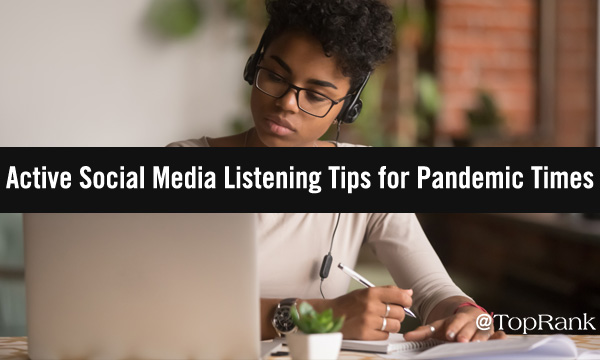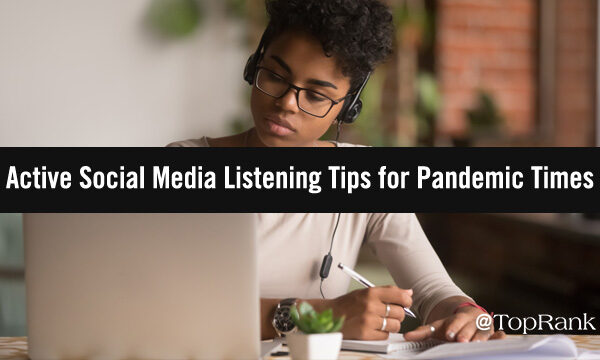
If you want to have a good business meeting, you want all the participants to actively listen. This requires participants go beyond hearing, and engage and analyze to form an actionable plan. It’s the same with social media listening. It requires marketers to move beyond monitoring to analyzing the full situation, which can often be a moving target.
Social media listening is an important first step when starting a new campaign or addressing a situation. When the current situation is heightened with a national emergency, marketers need to key in on their audience at a new level.
COVID-19 has changed the lives of folks around the world, including their social media habits. Facebook reports messaging increased more than 50% in March. According to Twitter, COVID-19 related Tweets are being shared every 45 milliseconds and #coronavirus is now the second most used hashtag of 2020.
In this fast changing environment marketers need to stay updated. The context of what is in the news and how it is playing on social media can directly impact your messaging from day to day. Let’s explore what social listening is, what you need to know to do it effectively, and how it can help you in this time of crisis.
What Is Social Media Listening?
Most organizations do some level of social media monitoring, where they keep track of who is mentioning the brand. But listening moves a step further, reviewing specific keywords, topics, competitors, or industries. Then, that information is analyzed and reviewed for actionable insights. So, it’s a two-part program: monitoring and analysis. The analysis allows you to understand your audience better and prepare or adjust your strategy.
The Basics of Social Listening
Monitoring and listening both happen with the assistance of social listening tools or software that aggregate multiple pieces of information into one, easy to use dashboard. When setting up your social listening dashboard, think about these key areas of focus:
- Brand reputation
- Brand names
- Key stakeholders
- Competitors
- Relevant topics
- Industry key terms
Fine Tune Your Social Listening Data
Monitoring competitors and industry key terms may be hard for some brands to understand when it comes to relevance. This is where advanced searches and the analysis tools will help you gain context and see changes in the market. The easiest way to set-up an advanced search is to use Boolean operators in your listening tool.
“For example, find all mentions of the overarching pandemic (e.g. “covid19 OR “covid 19” OR coronavirus OR “corona virus” OR pandemic) and then use qualifying search terms, so that the results must also include words that are specifically relevant to your business,” says Lance Concannon at Meltwater Social.
There is a lot of data to be had. Consider if you are collecting up all the content and data you really want, or is there some content throwing off your insights. “The first thing to do is manually check what you’ve collected. You don’t need to look at every single datapoint, but if something’s gone wrong you’ll be able to spot it,” points out Joshua Boyd at Brandwatch.
How to Approach Social Listening in Times of Crisis
Businesses need marketers to continue to keep the business moving forward, but we do not want to come off as tone-deaf. This is where understanding your social audience is key. Monitoring rapidly developing changes in the environment and messages, will help you share appropriate messages and content.
Social listening tools move beyond the top level of monitoring and help hone your strategy with deeper insights into the sentiment, regional differences, and understanding of the conversation.
“By keeping a finger on the pulse of the conversation and applying those insights to your approach, your brand can be a considerate, organic and valuable contributor to the conversation.” says Kristin Johnson at SproutSocial.
Add a New Dashboard
During this crisis time, there might be topics, questions and concerns outside of your normal searches.
“Think about the important stakeholder groups – employees, customers, partners – and what their specific concerns might be about how COVID-19 might impact your business. Employees will obviously be worried about their jobs, and what they should do during this time. Customers will want to know if you’re still able to provide the products and services they need, and might also have questions about customer support/service during the pandemic. Partners will have concerns around their ongoing relationship with your business,” says Lance Concannon.
“Think about the important stakeholder groups – employees, customers, partners – and what their specific concerns might be about how COVID-19 might impact your business.” @concannon Click To TweetYou may find your current dashboards are not providing you the insight you need to follow the conversation around all the COVID-19 related posts. It might be time to contact your listening program customer service and set up specific dashboards related to the epidemic.
In a recent email from Sprinklr’s Ragy Thomas, he shared that there are a number of ways the company is working to help customers through challenges related to COVID-19.
Sprinklr is helping customers who are already using Sprinklr’s Research product to create a COVID-19 listening dashboard that highlights where a brand is being mentioned across social media channels, blogs and news sites in association with COVID-19. Most importantly, the dashboard alerts brands of a potential crisis using Sprinklr Smart Alerts. Plus, Sprinklr is helping clients create presentations with live visualizations of COVID-19 listening data that can be shared with internal teams.
“Consider listening for changes in customer sentiment and behavior. Because the crisis may amplify distrust of brands”, says Laura Starita writing for Gartner. She suggests setting a voice of the customer (VoC) and listening for shifts and new references to the virus.
Evaluate and Implement
Once your monitoring is set up, you can move to the evaluation phase. Hootsuite suggests asking these key questions.
- How are other, similar organizations responding to the emergency? And how are their customers responding to their response?
- Do you need to craft content around your relief efforts, or new operational policies?
- Does your customer service team need to ramp up fast?
As you review your content, consider further filtering by demographics. The current crisis is global, and you may be addressing an audience in a particular region. Keep in mind each region may be dealing with a different stage of the crisis.
Don’t Just Hear Your Audience, Listen to Them
Don’t stop there. Listening is an ongoing team effort. The learnings you find now, will help you deal with the next marketing challenge.
For more help marketing during a pandemic, see Lee Odden’s post on understanding how to use SEO to surface key topics.



